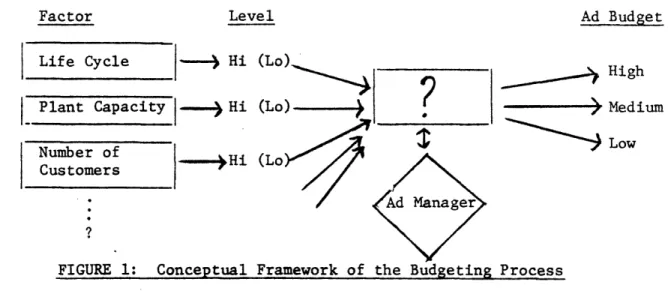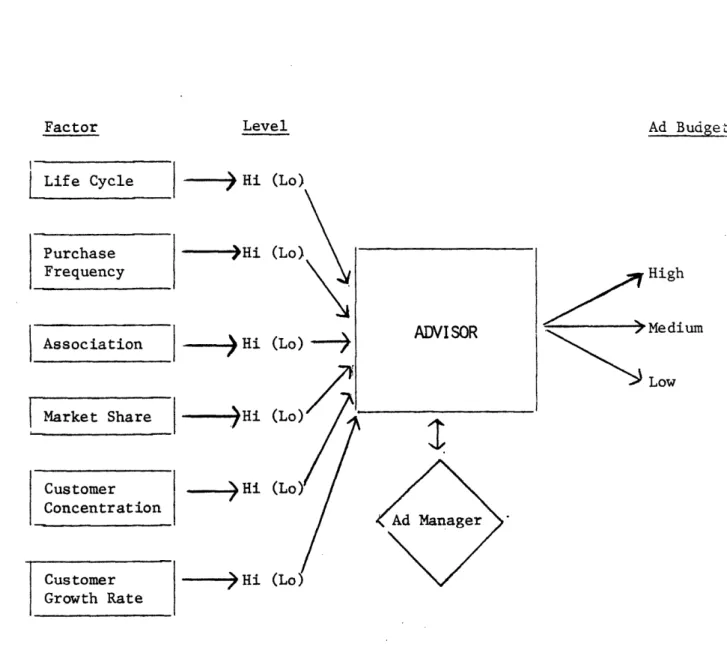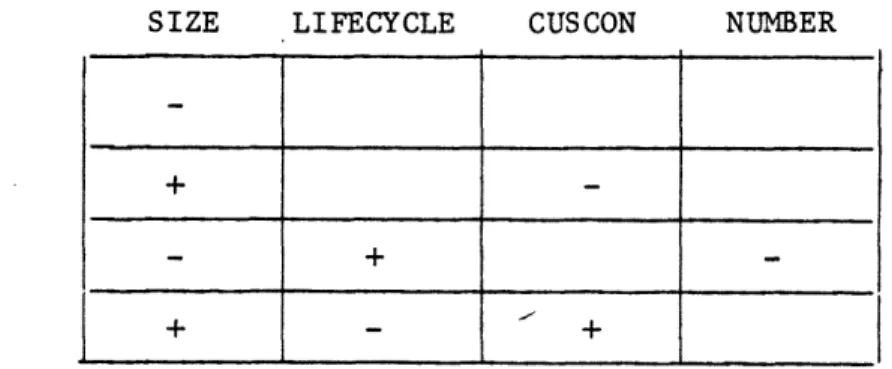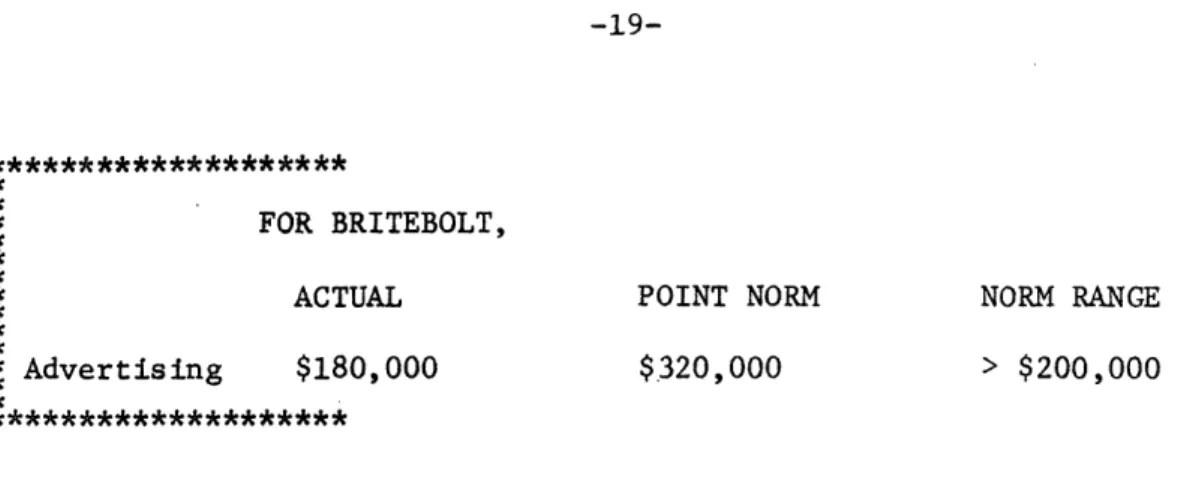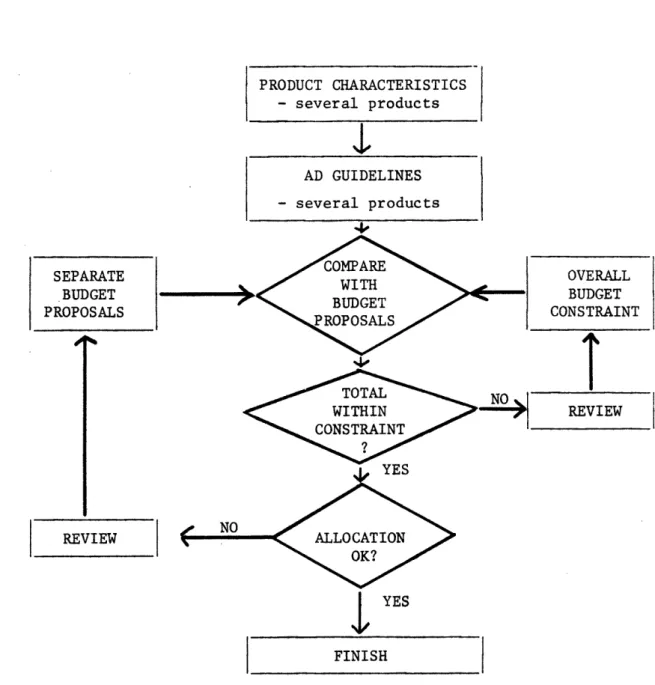Gary L. Lilien John D. C. Little
Companies selling to industrial and business markets face the problem of determining how much to spend for various elements in the marketing mix. Setting budgets for advertising expenditures is especially difficult.
This paper reviews the results of the ADVISOR project, a multi-company study of current practice in setting advertising budgets for industrial products. The motivation for the study is that, since information about advertising's effect on sales is virtually nonexistent for industrial pro-ducts, managers should tap the collective wisdom of those currently making advertising budgeting decisions.
Data on products from a number of large industrial companies have been analyzed to determine those product and market characteristics that affect advertising budgets as well as how those budgets are allocated across media. The study has produced new forms of guidelines for industrial
pro-duct managers, both for setting the overall advertising budget and for divid-ing it among media. In addition, new insight into the budgetdivid-ing process is gained by studying the process in two steps: setting an overall marketing budget and determining advertising's percentage of that budget.
We recently asked a product manager at a large manufacturing company, "How much do you spend in advertising your top-of-the-line filter pumps?
"Five percent of sales," he replied. "Why 5%?" we asked.
"Because 5% is what we have been spending and I'd have to explain 4% or 6% to my management!"
Realistic? Certainly. But satisfactory? Not really.
The ADVISOR* project, a joint ANA-MIT study of industrial advertising, has produced a new form of advertising budget guideline for industrial
product managers. The data needed to produce the guideline are a few pieces of information about the product and its market. The guideline draws upon marketers' experience as evidenced by their decisions: budgeting behavior
is inferred from a study of a broadly diversified sample of industrial products. Analysis of the products under study indicates that the most significant product and market characteristics affecting advertising budgets are
- stage in the life cycle - purchase frequency
- product quality, uniqueness and company association - market share
- customer concentration
- growth rate in number of customers.
Deeper study shows that budgeting practice can fruitfully be analyzed as a two-stage process:
(1) setting the ratio of Marketing/Sales and (2) setting the ratio of Advertising/Marketing
Together, these two figures determine the Advertising/Sales ratio and form budget guidelines.
The two-stage view of budgeting clarifies the role of different product and market characteristics. Stage in life cycle, customer concentration and market share primarily affect the Marketing/Sales ratio. By contrast, pur-chase frequency and product uniqueness, quality and company association primarily affect the Advertising/Marketing ratio. The growth rate in num-ber of customers affects each slightly. Putting together these separate
effects generates budget norms.
Further analysis of the data shows that product and market charac-teristics affect the way the advertising budget is split into
the major categories of Space, Direct Mail, Shows, and Promotion (sales promotions and other minor categories). This split is most strongly influenced by
- product sales
- customer concentration - stage in the life cycle - number of customers
This information is also used to develop norms for communications managers on the breakdown of the budget into major categories.
2. Study Background:
The ADVISOR study is an MIT research project coordinated by the Asso-ciation of National Advertisers and sponsored by 12 ANA member companies. The objective of the study has been to provide guidance for setting
indus-trial advertising budgets through an empirical study of current practice. Other studies have indicated that management decision-makers, while not making "optimal" decisions, on the average are good decision makers (see Bowman [1] and Kunreuther [2]). Thus a study of empirical practice which uncovers industry norms is of value to management, because those norms can be used to create guidelines. Put succinctly, everybody likes to know how other people are doing things.
A review of current budgeting methods (see Lilien et al. [3]) indi-cates that there are at least three techniques for allocating communications expenditures:
1. Guidelines Methods (Rules of Thumb). These include such
sugges-tions as "budget a constant percent of sales," "match competition," etc. 2. "Objectives"(Task) Method. This uses intermediate measures of
effectiveness for evaluating communication programs and establishes cost constraints for various portions of the total expense. The Task Method calls for explicit thought about various issues such
as position in the product life cycle, state of the marketing environment and corporate objectives.
3. Explicit Modeling and/or Experimentation. This approach relates marketing actions to profit or other objectives via theory and direct measurement.
None of these methods have been found to be a miracle cure. Present guide-line methods fail to answer the hard questions like "What percent of sales?" or "Why match competition -- what makes us think they're right?" Task
methods introduce intermediate variables but have difficulty relating them clearly to final measures of effectiveness. Explicit modeling and experimen-tation are generally expensive.
A review of the published material (Lilien et al. [31) indicates that (1) industrial advertising and personal selling can perform
comple-mentary and/or synergistic roles;
(2) increasing the share of total selling expense spent on adver-tising may be associated with lower selling costs relative to sales; and
(3) economies of scale (regions of expenditure in which additional increments of advertising yield increasing return) may exist for industrial advertising.
These phenomena carry major implications for expenditure policy. However, empirical evidence in this area is presently limited and can only be
regarded as suggestive. The study of the process and effects of industrial advertising has simply not progressed to the point where it can offer defini-tive guidance to industrial advertisers faced with specific expenditure deci-sions.
Current budgeting practice reflects the lack of knowledge about indus-trial advertising response. Both simple heuristics and the task method pro-vide a mechanism for controlling advertising spending. However, there are good reasons to believe that these methods can lead to inappropriate spending levels.
In light of this lack of quantitative guidance from the literature, ADVISOR infers budgeting norms from practice. The objective is to relate budgeting practice to product/market and environmental characteristics. But which characteristics? A review of advertising literature yielded a
list of variables to start with including stage in the life cycle, product uniqueness, frequency of purchase,-etc.
This initial set of characteristics was augmented by a series of un-structured interviews with product and advertising managers at some of the participating companies. The interview formats were basically similar: the product manager was asked to think of a product with a "high" ad budget and to describe its market and competitive situation. Then he was asked to con-sider a product with a low advertising budget and repeat the procedure. This procedure, repeated with 10-15 product managers in 5 companies, isolated a set of key characteristics which formed the basis for the first draft of a ques-tionnaire that finally included about 190 separate pieces of information in 46 questions.
Each participating company was asked to complete as many questionnaires (one for each product) as possible. A product is the physical item or set of items that is used as the basis for completing the questionnaire. Companies were given considerable flexibility in the definition of a product; the
definition chosen in a specific instance was to be one which had operational meaning for financial and planning purposes in that organization.
Judgmental answers or answers with some tolerance (say + 10%) were acceptable. This answer-tolerance fits into the project's objectives: since the goal is to relate advertising budgets to product/market environ-mental characteristics, the decision-maker's perceptions of characteristics
are the determining factors in the budget decisions. If a manager thinks he has 1000 potential customers, he will advertise accordingly even if he really has 10,000 potential customers.
A total of 65 completed questionnaires were returned by the partici-pating companies. The data were carefully screened for consistency and cross-checked with the companies before processing.
A statistical analysis of these data yielded the following:
a. The relationships of questionnaire variables indicates that Advertising/Sales may be modeled as the joint effect of Advertising/Marketing and Marketing/Sales.
b. The independent variables that are closely related to the dependent variable ratios listed in (a) above fall into the following
general categories.
1. Stage in the Life Cycle 2. Product perception 3. Growth rate
4. Frequency, quantity purchased 5. Buyer concentration
6. Company position, market share 7. Plant utilization
3. Guidelines for Setting the Advertising Budget
A review of the unstructured interviews held with advertising managers revealed the following kinds of explanations for certain high advertising budgets: "The product is early in its life cycle ... it has a large number of customers... we have much unused plant capacity ... etc." The specific, quantitative values (say, 12,800 customers) associated with these High-Low or Large-Small breaks never were mentioned.
If advertising managers make decisions on perceptions like High vs. Low in a particular variable category, then such two-level or dichotomous variables should be included in models of that budgeting process. Such a decision process also suggests that the output-norms should perhaps be in a High vs. Low or a High, Medium, Low form.
How should High and Low categories be constructed? In some cases the answer is unambiguous -- Stages 1 and 2 of the life cycle are "Early", 3 and 4 are "Late". In most cases, no such logical break-point exists and the sample medians from the questionnaire data were used.
The above discussion outlines a conceptual framework for the budgeting process. In this framework, the decision-maker is considered to have a check-list of product/market characteristics relevant to the budget decision. The values of the characteristics are known only roughly (High vs. Low, e.g.). The decision-maker then considers these characteristics one at a time, with the value of each characteristic adding or subtracting some value from the final budget score.
The guidance that the budgeter gets from the checklist is not a given
budget for this particular product should be low (< 1/3% of sales, e.g.) to be consistent with industry norms. Figure 1 illustrates the procedure con-ceptually. One takes a particular product through the checklist and gets guidance on whether the product's advertising budget should be High, Medium or Low.
Factor Level
Life Cycle I Hi (Lo)
Ad Budget
v n, -L
Plant Capacity
I
Hi (Lo) ) · ... MediumT
LowVumDer oU Hi (Lo
Customers
FIGURE 1: Conceptual Framework of the Budgeting Process
A modification of the above framework, suggested by analysis of the ques-tionnaire data, would be to consider the process as having two steps:
(1) Set an overall marketing budget where marketing here refers to advertising and personal selling, primarily. This might be done as a fraction of sales (Marketing/Sales).
(2) Decide what fraction of that marketing budget is to be allocated to advertising (Advertising/Marketing).
The advertising budget could then be viewed as
Advertising = Advertising Marketing
Marketing Sales x Sales.
Ii
'x'"I-"^I^---~-"--"-II---1 .. _ . . . , _ ,kT- __ 1- - - - C I YI ···The valuable aspect of viewing this process as a two step procedure is that some variables are associated with Advertising/Marketing, others with Marketing/Sales, still others with both. Separating the procedure into two parts allows insight into the determinants of the separate processes where a single step process may mask important information.
A series of regression analyses were run to develop relationships, illustrated in Figure 2.
FIGURE 2 -- Regression Results Summary - Budget
The variables included in these three models are interpreted as follows: LIFECYCLE -is the stage in the product life cycle with a higher number
meaning later in the life cycle.
FREQ - an index constructed from the average number of times/year an average customer purchases the product. A higher value refers to a more frequently purchased product.
QUAD - A variable constructed from three product questions related to product QUality, Association with the company and Dis-tinguishability from competitive products. A higher number on this variable refers to a product which is unique, closely re-lated to the company and of high quality.
Independent LIFE
Variables CYCLE FREQ QUAD MSR CUSCON CUSTGROW Dependent Variable Advertising/Sales - + + - + Advertising/Marketing + + + + Marketing/Sales -- - - + ____________________________________________ _______________ ________________- ,________________ ______________________
MSR - Product market share. Higher number here is a high mnarket share.
CUSCON - An index of customer concentration. A higher number here occurs if a large fraction of product sales go to the three largest customers.
CUSTGROW - Rate of growth in the number of company customers for the product. Higher values occur when there are many more cus-tomers in 1973 than in 1972.
To interpret the relationships in Figure 2, consider the rows of that figure one at a time. For Advertising/Sales:
(1) The earlier in the life cycle, the larger Advertising/Sales (A/S). (2) The more frequent the purchase, the larger A/S.
(3) The greater the product-company association, the larger A/S. (4) The smaller the market share, the larger A/S.
(5) The higher the growth rate, the larger A/S. For Advertising/Marketing:
(1) The greater the purchase frequency, the larger Advertising/ Marketing (A/M).
(2) The closer the product-company association, the larger A/M. (3) The greater the customer concentration, the larger A/M. (4) The greater the customer growth rate, the greater A/M. For Marketing/Sales:
(1) the earlier in the life cycle, the larger Marketing/Sales (M/S). (2) The smaller the market share, the greater M/S .
(3) The lower the customer concentration, the greater M/S. (4) The greater the customer growth rate, the greater M/S.
-11-Now consider the independent variables in Figure 2 one at a time.
Stage in the life cycle is related in the same way to Advertising/Sales and Marketing/Sales.
Purchase frequency affects Advertising/Sales by affecting the Advertising/Marketing ratio, not Marketing/Sales.
Product-company association affects Advertising/Sales in the same way as purchase frequency.
Market share is associated with the Advertising/Sales ratio through the Marketing/Sales ratio, not the Advertising/Marketing ratio.
Customer concentration does not affect the Advertising/Sales ratio. However, there is a negative relationship between customer concentration and
the Marketing/Sales ratio and a positive, counteracting relationship between customer concentration and the Advertising/Marketing ratio.
Customer Growth Rate is positively related to all three ratios.
Thus, most independent variables related to A/S seem to be highly related to either A/M or M/S, supporting the contention that modeling the A/S bucgeting procedure in two stages makes sense.
Variables that are missing, here, in the sense that contemporary marketing wisdom suggests they should be included in a relationship but which do not emerge statistically include:
- margin
- plant utilization
- user perception of price - industry profitability - number of competitors
- number of deciders/company
- directness of distribution channels
The non-inclusion of these variables could be due to one of several reasons --(a) they are in fact associated but not strongly enough to show up; (b) their effects are accounted for in combinations of other variables or (c) decision makers do not in fact consider these variables. Further study on a larger sample would be needed to give insight into these issues.
The sample was broken down into three groups of equal size according to the empirical A/S ratios and the groups were labeled High, Medium and Low. The model equations were used to predict (given the values of the independent variables) what the advertising to sales would be. The two-step procedure (using the A/M and M/S equations) did a bit better than the single equation in predicting the correct group 56% of the time. (A random classification would be expected to accurately classify 33% of the sample). Thus, given values of the independent variables in Figure 2, industry norms have been developed to suggest a High, Medium or Low advertising budget (relative to sales) for the product. Figure 3 gives a conceptual illustration of the role the model
can play in the budgeting decision process.
-13-Factor
I
Life Cycle Purchase Frequency I Association I Market Share Level Ad Budge i Hi (Lo) Hi (Lo ) Hi (Lo (Lo "-->--- Medium Low \ Hi (Lo Hi (LoFIGURE 3: ADVISOR's Role In The Decision Process
ADVISOR
Customer Concentration Customer Growth Rate -. _ J Hi4. Guidelines for Allocating the Advertising Budget
The results of the previous section provide guidelines to aid in the development of an overall advertising budget. The next decision is how to allocate those budget dollars to media. The analysis presented here suggests a breakdown into four categories:
Space = Trade, Technical press and House Journals
Direct Mail = Leaflets, brochures, catalogues and other direct mail pieces
Shows = Trade Shows plus industrial films
Promo = Sales promotion and other miscellaneous categories such as T.V., radio, and press releases
How should this breakdown be made? The logic of Figure 1 in the previous section holds here as well: The decision maker is viewed as having a checklist of characteristics (dollar sales, number of customers, etc.) known only roughly
(High vs. Low) and he considers these characteristics one at a time, with the value of each characteristic adding or subtracting from a final budget score. Figure 4 summarizes the results of a series of regression analyses which produced a set of four equations, one for each media category.
SIZE LIFECYCLE CUSCON NUMBER SPACE
SHOWS MAIL PROMO
FIGURE 4 -- Regression Results Summary - Allocation
- + I_
The variables included in the models are:
SIZE - a variable indicating dollar product sales. High values of this variable indicate high dollar sales.
LIFECYCLE - Stage in the product life cycle with a high number meaning later in the life cycle.
CUSCON - An index of customer concentration. A higher number here occurs if a large fraction of product sales go to the three largest customers.
NUMBER - Variable indicating number of customers for the product. High on this variable means many customers.
Let us summarize the results of the analysis in words below and offer some possible interpretations.
SPACE: The fraction of the budget allocated to SPACE is related only to the dollar sales of the product. As dollar sales go up, fraction in SPACE goes down. This is also the poorest of the equations, a possible indication that SPACE is a relatively
fixed fraction of most budgets, not easily affected by product/ market characteristics.
SHOWS: The larger the dollar sales, the more spent on SHOWS. Similarly, the less concentrated the sales to large customers (more custo-mers, effectively) the more spent on SHOWS. There is also a
relationship (too weak to include in the model) with purchase frequency -- the less frequent the average purchase, the more is spent on SHOWS.
MAIL: The larger the dollar sales of the product, the smaller the frac-tion spent on MAIL (due to a saturafrac-tion effect, perhaps). Products late in the life cycle spend proportionally more on MAIL (custo-mers are likely to be better known; few new custo(custo-mers are sought).
The more customers the lower the fraction spent on MAIL (Mail becomes inefficient when the number of customers is large). PROMO: The larger are dollar sales, the more is spent on sales
promo-tion and other media (this could be due to saturapromo-tion in the SPACE category). The earlier in the life cycle, the more is spent on PROMO (More sales promotion is likely in the product introduction stage). The higher the degree of customer concen-tration the more is spent on PROMD.
(Note that CUSCON and NUMBER are almost different views of the same phenomenon and, hence, are not included in the same model).
In the same way as in the previous section, for each of the equations above the sample was broken down into High, Medium and Low categories to test the predictive ability of the models. The fraction properly classified ranged from 55% to 74%, compared with an expected random classification accuracy (given three groups) of 33%. Thus, given data about the variables included in Figure 3, guidance or norms can be generated for the ad manager who wishes to allocate his budget across media.
5. Use of the Results
The results of the ADVISOR project can be used in a variety of ways to audit and support budget decisions. A review of the sample of products studied showed that 58% of the product-budgets were within guideline limits. The remaining 42%, outside of guideline limits, suggest the need for deeper product analysis.
An interactive computer program on time-sharing has been developed for the project participants. The program allows operation of the model in the user's office via a remote terminal. The program asks the user rele-vant questions from the project questionnaire and then prints back the budgeting and allocation guidelines determined by the model.
The program and the model are used in several ways. Currently the most frequent use, as a tool for Managerial Control, is outlined in Figure
5. Here characteristics for an existing product are collected and input to the program via a remote terminal. The program feeds back budgeting guidelines which are then compared with the actual budget. If the guide-lines agree with the budget, no further analysis is performed. If they disagree, reasons for the differences are sought. If special situations exist specific to the product or company, then, again, no further review is indicated. If no such conditions are found, either the product budget is modified or a special product audit is undertaken. In this mode of use, the model acts as a control procedure for exception analysis -- to find those product cases most in need of more detailed review.
PRODUCT CHARACTERISTICS
ADVERTISING GUIDELINES
OMPA
BUDGET + WITH AGREE
As~~
~UDGE
DISAGREE +-MODIFY BUDGET or INITIATE AUDIT1
Mode of Use 1 -- Managerial Control for an Existing Product A case summary of such use follows.
A product called BRITEBOLT (ficticious name) has $10,000,000 in sales, and an advertising budget of $160,000. It has the following product/market characteristics.
Characteristic LIFECYCLE
FREQ (Mean Purchase Frequency) QUAD (Association Index)
MSR (Market share)
CUSCON (Customer Concentration) CUSGROW (Customer Growth Rate)
Level EARLY 3 times/year (HIGH) .6 (HIGH) .13 (LOW) .20 (LOW) .0 (LOW)
The model generates the following budgeting norms (as well as other output on allocation): SPECIAL FACTORS PRESENT? FIGURE 5: I I . .
- -
-
-19-FOR BRITEBOLT,
ACTUAL POINT NORM NORM RANGE
* Advertising $180,000 $320,000 > $200,000
********************
Thus, according to the model, a budget-norm for a product of this type is $320,000, with a range estimate suggesting a budget over $200,000. A review suggests that the market for this product might be too widely de-fined and that this product really has a HIGH market share (MSR above) =.30. The model is re-run with the following result:
FOR BRITEBOLT,
* ACTUAL POINT NORM NORM RANGE
* Advertising $180,000 $250,000 > $140,000
* *******************
This revised output finds the actual advertising budget consistent with the model-suggested norm range, suggesting that budget practice is
consistent with norms for high market share products. Thus, a new under-standing of the product's market emerged from this analysis. In other cases more detailed product reviews or audits have been triggered, often resulting
in budget revisions.
Figure 6 describes a simple use of the model, i.e. when a new product is developed. In that case the known and anticipated characteristics of the product/market situation are used to determine budgeting norms for the
PRODUCT CHARACTERISTICS
1,,
FIGURE 6: Mode of Use 2 -- Advertising Budgets for a New Product
Figure 7 describes the use of the norms for allocation. Norms for several products are developed and compared. Marketing management can then use these norms to support and review the allocation of a fixed advertising budget or to help set that overall advertising budget.
The model is being used in other manners as well depending upon par-ticular organizations and users. In all cases, the model provides quantita-tive support for the difficult budget-setting and allocation decisions indus-trial marketing managers continually make.
ADVISOR ADVERTISING GUIDELINES
---
-21-.4
REVIEW
YES
FINISH
6. Are the Effects Real?
The ADVISOR study breaks new ground as the first extensive cross-sectional study of how product and market characteristics affect advertising budgeting practice. It is important, therefore, that potential users under-stand both the advantages and limitations of the research.
It is necessary to distinguish between the reality of an effect and the accuracy of its measurement. When you strain to see the details of a snowy TV picture, there is no doubt in your mind that the station is trans-mitting but you may have considerable doubt about what you are receiving.
Similarly, most of the advertising managers involved in the ADVISOR study believe that the major variables in the above models do, in fact, affect the advertising budget decision in an aggregate industry-average
way. However, in their personal experience with a limited number of products, they would be hard pressed to say which variable had how much effect.
The ADVISOR results improve this situation substantially. Certainly they confirm the original hypothesis that product and market characteristics affect advertising budgets. Furthermore the direction of the causality is
clear for most of the variables because of their inherent nature. Thus, advertising cannot cause a product's stage-in-life-cycle and would not be expected-to affect its frequency of purchase in any substantial way. In-stead, stage-in-life-cycle and frequency of purchase affect advertising budgets.
Besides confirming the basic presumption of the study, the ADVISOR results place magnitudes and ranges on the effects of key variables. This is obviously new knowledge. The accuracy of the measurement varies from
I_______XC--^I__l---case to I_______XC--^I__l---case and is limited by the sample size that the study was able to achieve. Nevertheless the results are what they were intended to be: play-backs of business practice which identify significant effects and which can be used as norms and guidelines by industrial marketing communications managers.
Another important point in understanding the results is the difference between the accuracy of measuring an effect and accuracy of prediction. If
the study had contained a hundred times again as many products, we would have had dramatically better measurements of the contributions of specific variables to the A/S ratio (about 10 times more accurate). Almost certainly, a number of variables not now statistically significant would be
success-fully measured. These would be variables whose contributions are small and are now swamped out by measurement variance.
On the other hand a dramatically larger sample would probably not increase very much our predictive accuracy for individual A/S ratios. This is because there are extraneous factors affecting the A/S ratio (e.g., specific budget pressures in companies at particular points in time). Special local factors will not be accounted for by any set of variables that can reasonably be included in such a study. The situation is analogous to determining the mean height of U.S. males. Increasing a sample from 100 to 10,000 would increase the accuracy of measuring the mean greatly but would not improve the mean as a predictor of a given person's height.
In summary, therefore, we say, yes, real effects have been measured. The measurements vary in accuracy and must be interpreted in the context of the data base and the analysis, but they represent substantive new knowledge about setting of industrial advertising budgets.
7. Further Work
The ADVISOR study breaks new ground in providing empirical support for industrial marketing decision-making. There is no claim that these results are a "final answer." The data base was small as was the number
of companies. In addition, no study of practice can develop results which can unambiguously be adopted for use -- users must be convinced that industry's collective wisdom is valid for their particular problems.
Thus, there are several alternatives for further work in this area. One would be to extend the number of companies and the data base to test and improve the models developed. Many of the results would be more definitive if verified on a larger sample.
Another direction for future work is to explicitly study what industrial marketers should do, even if they are not now doing it. Fewer products would be used in such a study, but much more detailed analysis would be performed. Time series data would be collected, alleviating some cause and effect diffi-culties always present in purely cross-sectional analyses. Some experimenta-tion, either of the controlled or natural variety, would help lead to stronger results.
Both of the above research directions are now being followed in a
follow-up study, which promises even deeper insight into the budgeting
process and more powerful results for industrial marketing management.
---
-25-References
1. Bowman, E. H. "Consistency and Optimality in Managerial Decision Making," Management Science, Vol. 9 (January 1963), pp. 310-321. 2. Kunreuther, Howard. "Extensions of Bowman's Theory of Managerial
Decision-Making," Management Science, Vol. 15 (April 1969), pp. B-415-439.
3. Lilien, G.L., A.J. Silk, J-M Choffray and M. Rao, "Industrial Adver-tising Effects and Budgeting Practices: A Review," Journal of Marketing, (January 1976), forthcoming.
